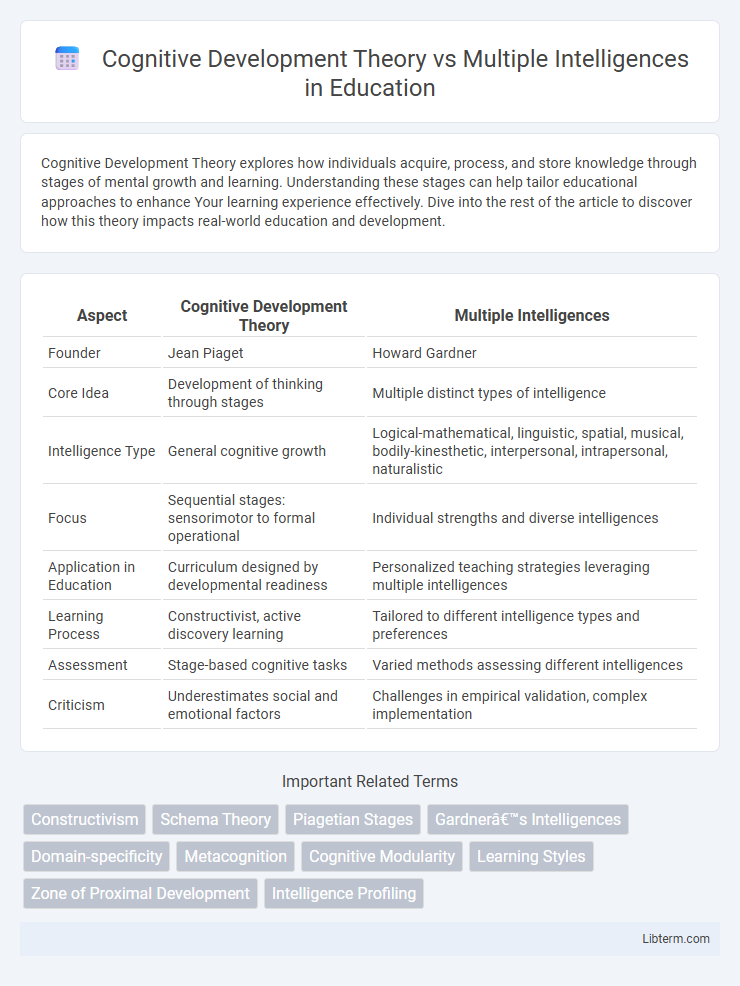Cognitive Development Theory explores how individuals acquire, process, and store knowledge through stages of mental growth and learning. Understanding these stages can help tailor educational approaches to enhance Your learning experience effectively. Dive into the rest of the article to discover how this theory impacts real-world education and development.
Table of Comparison
| Aspect | Cognitive Development Theory | Multiple Intelligences |
|---|---|---|
| Founder | Jean Piaget | Howard Gardner |
| Core Idea | Development of thinking through stages | Multiple distinct types of intelligence |
| Intelligence Type | General cognitive growth | Logical-mathematical, linguistic, spatial, musical, bodily-kinesthetic, interpersonal, intrapersonal, naturalistic |
| Focus | Sequential stages: sensorimotor to formal operational | Individual strengths and diverse intelligences |
| Application in Education | Curriculum designed by developmental readiness | Personalized teaching strategies leveraging multiple intelligences |
| Learning Process | Constructivist, active discovery learning | Tailored to different intelligence types and preferences |
| Assessment | Stage-based cognitive tasks | Varied methods assessing different intelligences |
| Criticism | Underestimates social and emotional factors | Challenges in empirical validation, complex implementation |
Introduction to Cognitive Development Theory and Multiple Intelligences
Cognitive Development Theory, pioneered by Jean Piaget, explores how children's thinking evolves through distinct stages, emphasizing processes like assimilation, accommodation, and schema formation. Multiple Intelligences Theory, developed by Howard Gardner, challenges traditional IQ-based views by identifying diverse intelligences such as linguistic, logical-mathematical, spatial, and interpersonal intelligences. Both theories provide foundational frameworks for understanding human learning and intellectual growth from different but complementary perspectives.
Historical Background of Cognitive Development Theory
Cognitive Development Theory, pioneered by Jean Piaget in the early 20th century, revolutionized psychology by outlining stages of mental growth from infancy to adulthood. Piaget's research emphasized how children construct knowledge through interaction with their environment, forming the basis of modern developmental psychology. This theory contrasts with Howard Gardner's Multiple Intelligences, introduced in 1983, which expanded intelligence beyond cognitive abilities to include diverse intellectual capacities.
Key Concepts in Jean Piaget’s Cognitive Development Theory
Jean Piaget's Cognitive Development Theory emphasizes stages of mental growth, including the sensorimotor, preoperational, concrete operational, and formal operational stages, each characterized by distinct cognitive skills and ways of understanding the world. Key concepts such as assimilation, accommodation, and schema formation explain how children adapt and build knowledge through interaction with their environment. Unlike Gardner's Multiple Intelligences theory, which highlights diverse forms of intelligence like linguistic, logical-mathematical, and interpersonal, Piaget's theory focuses on the progressive development of cognitive structures that underpin learning and reasoning.
Overview of Howard Gardner’s Multiple Intelligences Theory
Howard Gardner's Multiple Intelligences Theory proposes that intelligence is not a single general ability but a combination of distinct modalities, including linguistic, logical-mathematical, spatial, musical, bodily-kinesthetic, interpersonal, intrapersonal, naturalistic, and existential intelligences. This theory challenges traditional cognitive development models by emphasizing diverse ways individuals comprehend and interact with the world, expanding educational approaches to cater to varied learning styles. Gardner's framework influences curriculum design and teaching strategies, promoting personalized learning experiences that harness students' unique strengths.
Core Principles: Comparing Cognitive Development and Multiple Intelligences
Cognitive Development Theory, pioneered by Jean Piaget, emphasizes structured stages through which children's thinking evolves, highlighting processes like assimilation and accommodation. Multiple Intelligences Theory, developed by Howard Gardner, proposes that intelligence is diverse and multifaceted, encompassing linguistic, logical-mathematical, spatial, musical, bodily-kinesthetic, interpersonal, intrapersonal, and naturalistic intelligences. While Cognitive Development focuses on qualitative changes in thought processes, Multiple Intelligences centers on recognizing individual strengths across various cognitive domains.
Educational Implications of Both Theories
Cognitive Development Theory emphasizes the sequential stages of intellectual growth, guiding educators to design age-appropriate learning activities that match students' cognitive abilities and promote critical thinking skills. Multiple Intelligences Theory advocates for recognizing diverse learning styles, encouraging differentiated instruction that addresses linguistic, logical-mathematical, spatial, musical, bodily-kinesthetic, interpersonal, intrapersonal, and naturalistic intelligences. Integrating both theories in education fosters a holistic approach by combining cognitive readiness with varied instructional strategies, enhancing student engagement and personalized learning outcomes.
Criticisms and Limitations of Cognitive Development Theory
Cognitive Development Theory, primarily advanced by Jean Piaget, faces criticism for underestimating children's cognitive abilities and its stage-based approach, which may not account for individual variability and cultural influences. The theory's emphasis on universal stages overlooks the diverse ways intelligence manifests, contrasting with Howard Gardner's Multiple Intelligences Theory that highlights distinct types of intelligences such as linguistic, musical, and interpersonal. Critics argue that Piaget's model lacks flexibility and fails to integrate the broader spectrum of human cognitive strengths recognized in Multiple Intelligences.
Challenges and Critiques of Multiple Intelligences Theory
The Multiple Intelligences Theory faces challenges concerning its empirical support, as critics argue there is limited scientific evidence validating the distinct categories of intelligence proposed by Howard Gardner. Its broad definition of intelligence complicates standardized assessment and educational application, leading to inconsistent implementation in curricula. Critics also highlight that the theory may underestimate the role of general cognitive abilities emphasized in traditional intelligence research.
Integrating Cognitive Development and Multiple Intelligences in the Classroom
Integrating Cognitive Development Theory and Multiple Intelligences in the classroom enhances personalized learning by addressing students' varying cognitive stages and diverse intelligence profiles, such as linguistic, spatial, and kinesthetic. Tailoring instruction to both cognitive readiness and multiple intelligences promotes deeper engagement and critical thinking, fostering holistic intellectual growth. Educators strategically design activities that simultaneously advance cognitive skills and leverage individual intelligence strengths, leading to improved academic outcomes and motivation.
Conclusion: Future Directions and Research in Educational Psychology
Future research in educational psychology should integrate Cognitive Development Theory with Multiple Intelligences to create more personalized learning approaches that address diverse cognitive profiles and intelligence modalities. Emphasizing neurodevelopmental studies and adaptive teaching technologies can enhance understanding of how developmental stages interact with multiple intelligences in varied learning environments. This interdisciplinary focus aims to optimize educational strategies, improve student engagement, and foster holistic cognitive growth across age groups.
Cognitive Development Theory Infographic

 libterm.com
libterm.com